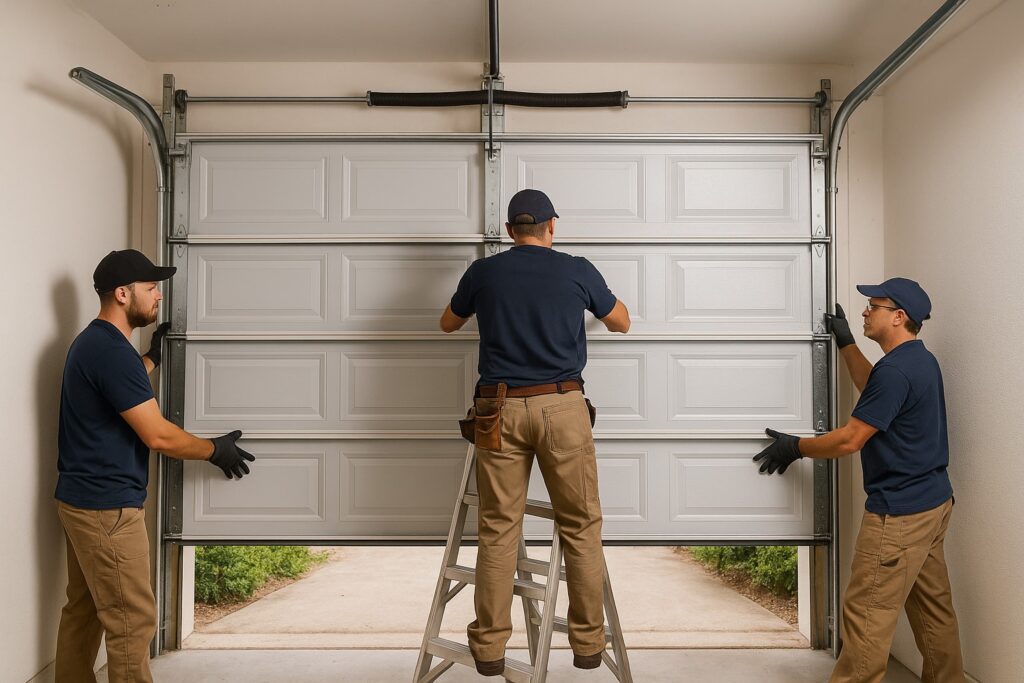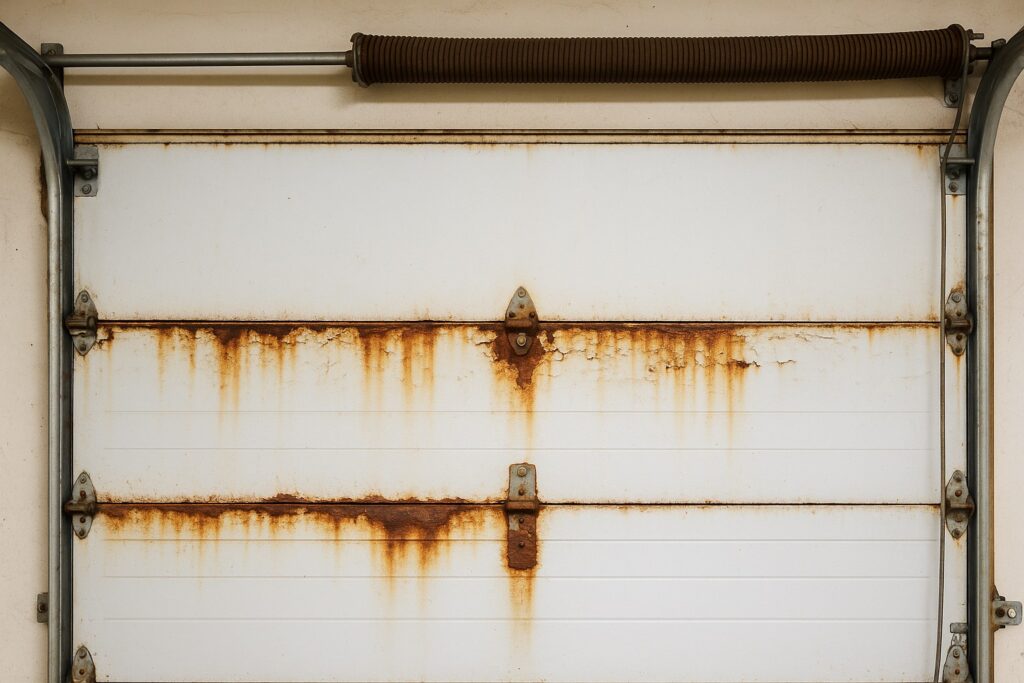Everything You Didn’t Know You Needed About Residential Garage Door Installation in Houston

By White Oak Overhead Doors Co.
When the Smith family in Houston couldn’t open their garage on a rainy Monday morning, they quickly realized their garage door opener had failed, and worse, so had their torsion springs. What started as a frustrating delay turned into a full residential garage door installation project. Our team at White Oak Overhead Doors Co. stepped in with the necessary tools, from power drills and screws to center brackets and torsion tubes, ensuring a smooth operation from start to finish. Now, they enjoy a secure, quiet, and energy-efficient garage door system that adds both safety and curb appeal to their home.
According to the U.S. Department of Energy, nearly 30% of a home’s energy loss occurs through gaps and poorly insulated areas, garages being one of the biggest culprits. In a hot and humid city like Houston, choosing a new garage door with high R-values (a measure of insulation effectiveness) can help conserve energy and reduce cooling costs significantly.
Many homeowners overlook their garage doors until something breaks. But a proper residential garage door installation is not just about aesthetics or function. It’s a critical step toward maintaining your home’s safety, insulation, energy efficiency, and long-term property value. If you’re in Houston and considering a new garage door, this comprehensive guide will walk you through the entire process and what to expect.
Why Residential Garage Door Installation Matters
Your garage door isn’t just a moving wall; it’s the largest door in your home and one of its most important security features. A professionally installed residential garage door provides smooth operation, weather resistance, and thermal insulation. It also serves as a key entry point, especially when your garage connects directly to your home.

Houston’s unpredictable climate, ranging from heavy rainfall to extreme heat, can wear down a poorly installed or old garage door. Water can rust hinges, corrode bolts, and warp wooden panels. Heat can cause torsion springs to expand and lose tension, making the door harder to lift or close. Installing a new door with weather-sealed bottom panels, insulated garage door sections, and corrosion-resistant hardware ensures long-term durability.
A proper garage door installation uses heavy-duty vertical tracks and horizontal tracks that guide each section of the door with stability and safety. The flag brackets and cable drums are mounted correctly to the header to avoid slack cables, which can cause jerky or uneven movement. When the job is done right by professionals, everything from the torsion spring tension to the panel alignment contributes to smooth, quiet, and secure operation.
Common Signs You Need a New Garage Door
Wondering if it’s time to install a new door? Here are several red flags to look out for:
- Excessive Noise: Grinding, squealing, or rattling noises from the hinges, torsion springs, or garage door opener can indicate major issues.
- Frequent Repairs: If you’re replacing panels, tightening bolts, or adjusting track alignment more than once a year, it may be time to consider a full system replacement.
- Sagging or Warped Panels: Old wood panels or steel doors can sag over time, affecting the balance and safe operation of the system.
- Rising Energy Bills: Poor insulation can let in heat and cold, pushing your HVAC system to work overtime.
- Outdated Safety Features: Modern doors include safety sensors and smart garage door openers that prevent accidents and unauthorized access.

The Installation Process: Step-by-Step Guide
At White Oak Overhead Doors Co., our installation process is more than just hanging a door. It’s a technical, step-by-step service that includes safety checks, custom fitting, and proper balancing for long-term performance.
1. Site Inspection & Measuring the Garage Opening
We begin with a full inspection of your garage wall, garage ceiling, and garage floor. Measurements of the garage door opening, header, and side spaces ensure the right fit. We check for obstructions like electrical outlets or light fixtures.
2. Selecting the Right Garage Door
We help you choose a garage door that meets your needs, whether it’s a modern aluminum panel door, a classic carriage-style wooden door, or a heavy-duty insulated steel option with high R-values. The insulation levels, materials, aesthetic appeal, and operation style (manual vs. automatic) are all considered.
3. Gathering Necessary Tools and Hardware
From vise grips, socket wrenches, and power drills to screws, torsion springs, flag brackets, and rollers our technicians come fully equipped with everything required for a successful garage door installation.
4. Removing the Old Garage Door
Carefully dismantling the old system involves releasing spring tension with proper safety techniques, unscrewing the brackets, and removing each garage door section. We take all safety precautions, including securing the panels with vise grips to prevent accidental drops.
5. Installing the New Door Panels and Tracks
Each section of the garage door is assembled beginning with the bottom panel and working up to the top section. Hinges are installed between panels, and side brackets are mounted. The vertical track is aligned with the rollers and secured to the wall. Then, we install the horizontal tracks and torsion tube, aligning everything to ensure even weight distribution.
6. Installing the Torsion Springs and Cable System
Springs are wound clockwise using specialized tools to the proper tension. The torsion tube is fastened securely to the center bracket and end bearing plates. Cables are attached to the bottom bracket and wound around the drums to ensure smooth lifting.
7. Mounting the Garage Door Opener
If an opener is part of the system, we install and program it, mount the opener motor to the ceiling, attach the opener arm to the top section of the door, and test it for smooth and safe operation.
8. Testing, Balancing, and Final Walkthrough
The door is manually lifted to check its balance. Sensors are tested, safety features are reviewed, and adjustments are made. We walk you through upkeep tips like lubricating hinges, checking spring tension, and testing auto-reverse functionality.
Features to Look for in a New Garage Door
Your door isn’t just about looks, it’s also about function and durability. Consider these essential features:
- High-Quality Insulation: Look for doors with polyurethane or polystyrene cores for better R-values.
- Durable Materials: Galvanized steel, aluminum, or composite doors offer rust resistance and strength.
- Weather Seals: A proper bottom seal and perimeter seal keep out water and pests.
- Smart Technology: Choose a garage door opener that connects to your smartphone or home automation system.
- Reinforced Hardware: Heavy-duty springs, brackets, and hinges ensure long-term performance.
Garage Door Styles Perfect for Houston Homes
Houston homes come in all shapes and sizes. That’s why your garage door style should complement your architecture:
- Modern Panel Doors: Clean lines with energy-efficient insulation.
- Carriage House Doors: Add charm and curb appeal.
- Glass & Aluminum Doors: Perfect for a modern or industrial aesthetic.
- Steel Raised-Panel Doors: Affordable, low-maintenance, and weather-resistant.
Maintenance Tips for Long-Term Performance
A garage door is a long-term investment. Keep it in top shape with these maintenance tips:
- Monthly Visual Checks: Look for rust, cracks, or loose hardware.
- Lubrication: Apply garage door lubricant to rollers, hinges, and springs every 3–6 months.
- Test Balance & Safety Sensors: Check the auto-reverse feature monthly.
- Clean Tracks & Tighten Bolts: Use a dry cloth to clean tracks and retighten any loose screws or bolts.
- Avoid DIY Spring Repairs: Torsion spring repairs should only be done by professionals to prevent injury.
Why Choose Professional Installation Over DIY
While DIY garage door installation videos might seem tempting, the process involves working with heavy panels, high-tension springs, and complex systems that can be dangerous if mishandled. Mistakes in bracket alignment, spring tension, or opener setup can lead to serious injuries or system failure.
Professional installation ensures:
- Proper alignment of tracks, panels, and brackets
- Safe and correct tensioning of torsion springs
- Code-compliant and secure installation
- The manufacturer’s warranty remains valid
- Safe operation from day one
How Can White Oak Overhead Doors Co. Help You?
At White Oak Overhead Doors Co., we are your trusted local experts for residential garage door installation in Houston, TX. Our team of trained technicians uses the highest quality materials, advanced tools, and proven techniques to ensure a seamless, safe, and professional installation process.
We don’t just install new garage doors; we provide a full-service experience, from helping you choose the right design to ongoing maintenance and repairs. Whether you need insulated panels, a smart garage door opener, or durable torsion springs built to handle Houston’s heat and storms, we’ve got you covered.
📍 Visit Us:
1440studemont St, Houston, TX 77007
📞 Call Us:(832) 990-1595 Ready to upgrade your garage with a secure, energy-efficient, and stylish new door?
Call White Oak Overhead Doors Co. today for your free quote and expert consultation.
FAQs About Residential Garage Door Installation
1. How long does it take to install a residential garage door?
Most professional installations take between 3 to 6 hours, depending on the size, door type, and whether an opener is included.
2. What size garage door is standard for a residential home?
The standard single garage door size is 8 to 9 feet wide by 7 to 8 feet high, while double doors are typically 16 feet wide.
3. Can I replace just one panel of my garage door instead of the entire door?
Yes, in some cases, you can replace a single damaged panel, but it must match the existing sections in size, design, and color.
4. What is the average lifespan of a garage door?
A properly maintained garage door typically lasts 15 to 30 years, depending on material, usage, and environmental exposure.
